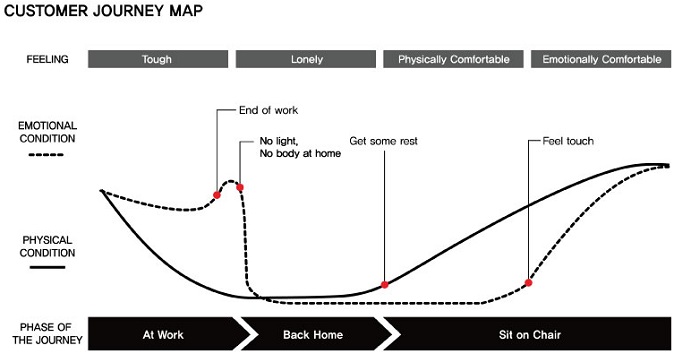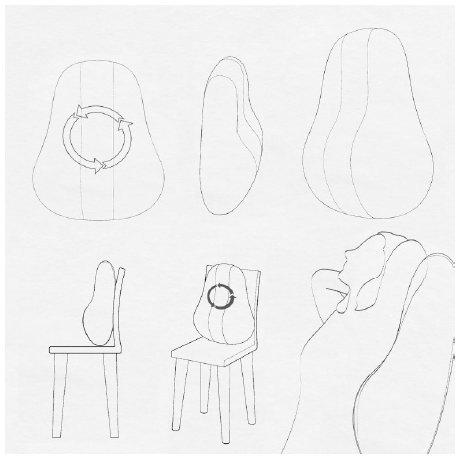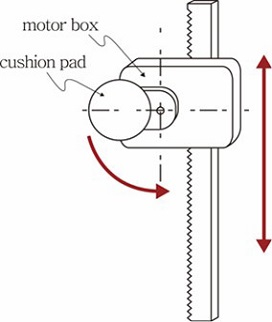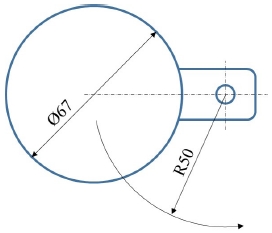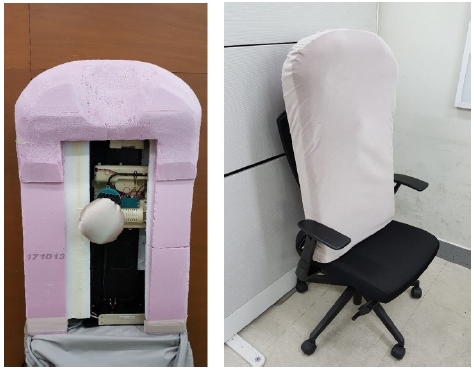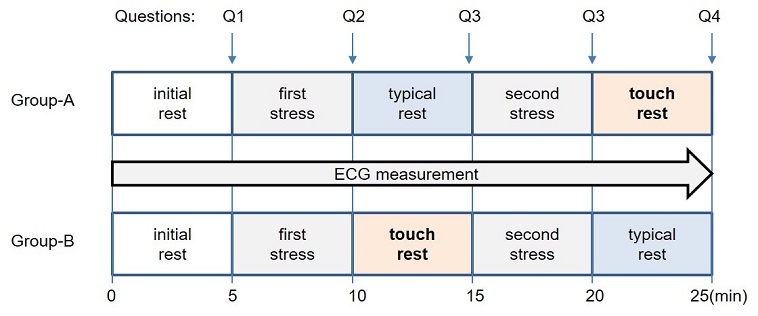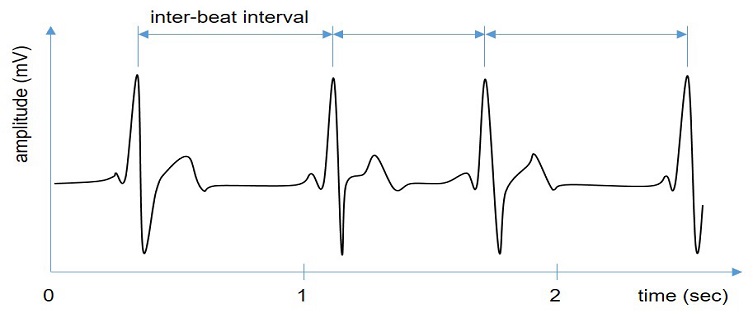
An Emotional Comfort Product Using Touch : The Possibility
Background In today’s complex and rapidly changing society, people need emotional and physical comfort. It is known that touch is beneficial for the emotional comfort of animals and humans. Many people consider comfort objects as essential to their mental and emotional well-being. The main purpose of this paper is to investigate the possibility of the touch product that provides emotional comfort.
Methods This paper proposes a concept design of an emotional comfort product that imitates a mother’s hand on the back of the user. To verify the effects of the comfort product, a prototype has been developed and an experiment has been conducted using the prototype. The experiment tests the hypothesis: Relaxation using the product results in a more comfortable emotional response when compared to typical relaxation. The experiment considers two data groups of stress levels: typical-rest and touch-rest.
Results Mental stress increased in both ‘stress’ phases and decreased in the ‘rest’ phases. The mean stress level of the ‘touch-rest’ phase was significantly lower than the mean stress level of the ‘typical-rest’ phase.
Conclusions The aim of this study is to identify the possibility of touch products that provide emotional comfort. In the experiment of this study, we observed that a touch product prototype helped lower the stress level.
Keywords:
Touch, Prototype, Emotional Comfort, Conceptual Design, Possibility Test1. Introduction
In today’s complex and rapidly changing society, many people are mentally challenged. They need emotional comfort as well as physical comfort to overcome their mental difficulties in modern society. It is known that touch is beneficial for the emotional comfort of animals and humans. However, few products directly support mental or emotional desires, such as the warmth of a mother’s hand.
A comfort object, such as a doll or a teddy bear, can provide psychological comfort at bedtime for children. Adults also use comfort objects, such as a security blanket, especially in unusual situations. Many people consider comfort objects as essential to their mental and emotional well-being (Papas, 2010). A recent study (Kane et al., 2019) showed that touch pressure by weighted blankets can be an effective psychological relaxation modality. However, most comfort objects are passive. The user should actively touch and hug the object to feel its softness and to be comforted. Some products, such as psychotherapy robots, actively respond to people in limited situations. Also, massage machines actively provide muscle stimulation. It is known that muscle stimulation relaxes the muscles and provides physical rest and comfort (Field, 2016).
The main purpose of this paper is to investigate the possibility of touch products that provide emotional comfort. To investigate the possibility, this paper presents the conceptual design of a product that imitates the motion of a mother’s hand and provides emotional comfort. With regard to the conceptual design, design considerations are described first. The design considerations include the shape, material and function of the product. The core function of the product, emotional comfort, is verified with a prototype and in experiments. The findings suggest the possibility of products capable of providing emotional comfort through touch.
2. Touch and Emotional Comfort
The sensations felt in the skin include touch, a sense of pressure, a sense of temperature, and a sense of pain. According to Kruger (Friedman and Carterette, 1996), the sense of touch is aroused through mechanical stimulation of receptors in the skin – pressure, temperature, and various blends of these attributes. Pressure applied to the skin is the primary stimulus for the sense of touch. Depending on the intensity of the pressure, touch functions as a skin stimulus and as a muscle stimulus. Another stimulus, vibration, emerges when there are rapid and regular changes in the pressure. The feeling of touch is also linked to human emotions, with attributes such as smoothness, hardness, stiffness, elasticity, and temperature affecting emotions. However, this study limits the meaning of touch to mechanical stimulation that causes a skin stimulus and provides emotional comfort. Emotional comfort is the result of an experience, referring here to a perceived personal psychological status (Kukhta and Pelevin, 2015). Emotional comfort is defined as pleasant positive feelings, a state of relaxation, and an optimistic approach to life, where a person feels happy and in a good mood, i.e., in high spirits. Emotional comfort is associated with less physical discomfort.
The proper intensity of touch can vary depending on the person or situation. Some research shows that a touch with strong pressure calms psychological pain and relieves fear. Bartens (2014) suggested that the intensity of the pressure for a proper touch varies from person to person. Loken et al. (2009) stimulated forearm skin with soft brush stroking using different speeds and forces, finding that touch-sensitive nerve fibers, known as C-tactile fibers, respond most vigorously at intermediate velocities. They proposed that C-tactile fibers are tuned to slow and gentle stimulation that most likely occurs during interactions associated with close relationships, especially between mothers and infants. The proper strength of the touch may vary from person to person, as the intensity levels of the pressure required for a baby and those for an adult also differ.
Touches can be divided into three types depending on the touch method: active touches, passive touches, and visual touches. Gibson reported in his well-known great cookie-cutter experiment (Harre, 2006) that active touch identifies objects better than passive touch. When one actively touches an object, they focus on its properties. However, when one is touched passively, they focus on the sensation.
Harlow's attachment experiment proved that touch is a very important factor with regard to emotional comfort (Harlow, 2017). His subsequent research revealed that contact comfort is necessary for the healthy emotional, cognitive and social development of a person. Tjew-A-Sin et al. (2016) showed that emulated interpersonal touch increases task engagement. Based on existing researches, we assume that a product that provides physical contact will help people by providing comfort during stressful times.
The Touch Research Institute (Research at TRI, 2018) has done a considerable amount of research on the effects of massage therapy. They suggest that massage therapy is effective for depression in children and teenagers, for bulimia in girls, and for attention deficit hyperactivity disorder (ADHD), post-traumatic stress disorder (PTSD) and autism. However, most studies focus on muscle massage and not on touch.
A typical touch product is the psychotherapy robot PARO (2018), developed by a Japanese industrial automation company. When gently petting PARO’s body, it emits sounds which convey happiness and expresses feelings of comfort. PARO can make an emotional connection with the user while expressing feelings, but it does not actively provide emotional touch.
Temple Grandin (2012) developed a squeeze machine with two cushions (Sensory/Therapy, 2018). The squeeze machine has been proven as a treatment device and is used for the treatment of autistic children. Grandin has stated that the intensity of the pressure is important when using the squeeze machine and that proper pressure rather than weak pressure is more effective for psychological sedation. However, the squeeze machine is a device for autistic children, and it presses the body with force. It does not touch the skin of the user, nor does it move slowly and/or gently.
3. Design and Prototyping
3. 1. Concept Design
In general, product design factors consist of the product’s function, form, materials, and manufacturing process (Ullman, 2003). Form includes the product’s architecture, its shape, its color, its texture, and other factors related to its structure. However, in terms of user experience design (UX design), there are several different design factors: the user and user environment, context, usage, and interaction, among others. This paper focuses on the function of the product design factors, which can describe what the product does. Related to the function are the product’s form, materials, and manufacturing process.
For the proper design of the functions, we created the user journey map shown in Figure 1. In the map, the situation depicted is when a user returns home after a bad day at work. When the user arrives home, there is no light and no other people in the house, and the little relief he/she feels suddenly turns into loneliness. However, sitting on a sofa and taking a rest, the user recovers not only physically but also emotionally. Therefore, a product should be designed for people who are alone at home after work, and an emotional touch should be provided to such a person as they sit on a chair and rest. Figure 2 shows idea sketches of the product and an example of its use. The concept of the idea is to imitate the touch of a mother stroking a baby.
For the functional design of the comfort product, design factors such as touch types, the patterns and speed of the touch motions, and the pressure and locations of the touches were considered. As described in the previous section, when one is touched passively, the focus is on the sensation rather than the object. Therefore, the product should be designed to move actively and provide the user with touches. The most desirable usage is that it automatically operates when the user feels lonely, providing the user with emotional touches.
The location of a touch should be hairy skin, because C-tactile nerve fibers, which contribute critically to a pleasant sense of touch, are found in hairy skin but not glabrous skin (Loken et al., 2009; McGlone et al., 2012). In this study, the product has been designed to provide touches on the upper back of the user, as it is easy to access this location when the user is sitting without interference with regard to visual imagination. The pattern of the touch motion should imitate the pattern of a mother stroking the back of a baby, so the pattern should be a circular motion with a diameter of 100 to 200 mm. The speed and pressure of the motion for a pleasant touch should be determined appropriately. Loken et al. (2009) suggested that 10 to 100 mm/sec is most effective to activate C-tactile nerve fibers in an experiment with a soft brush stroking the forearm (Ackerley et al., 2014). In the experiment, they used two different normal forces (0.2N and 0.4N), but they could not find a relationship with regard to the force. The form and material of the product should be also soft, warm and comfortable.
In summary, we suggest an emotional comfort product for people who are alone at home after a difficult day and in other similar situations. The product imitates a mother’s hand on the back of the user, and it moves automatically in a circular motion.
3. 2. Prototyping
Because the core of the proposed product is to provide emotional comfort and given that there are no similar products, functional verification is important. For the functional verification of the product, a prototype was made and was used for user testing. The conceptual frame for the prototype is shown in Figure 3. Because it was difficult to implement while also providing stable motion, we used a commercial massage device as a base frame. The massage device was equipped with a hard massage pad to relieve muscular tension. Therefore, a lightweight cushion pad filled with cotton and wrapped in satin cloth, to provide a soft touch stroke, was used to replace the hard pad. The satin cloth served to reduce the friction between the user’s clothes and the cushion pad.
As the cushion pad rotates, the device provides the user with the feeling of being stroked on the back when the user reclines. The soothing motion of the massage device was also changed. As shown in Figure 4, the radius of the soft cushion pad is approximately 67 mm, and the circular radius to the center of the pad is close to 50 mm. The speed of motion was adjusted for smooth stroking, and it made 15 revolutions per minute. Therefore, the linear velocity of the center of the pad is 79 mm/sec, and the maximum velocity at the outmost of the circular motion is 131 mm/sec. Unfortunately, the device cannot determine the user’s mood or operate automatically, nor can it actively control the intensity of the touch pressure. Figure 5 shows the implemented prototype.
4. Experiments
4. 1. Experimental Hypothesis
This study aims to verify the effect of ‘touch rest’ in comparison with ‘typical rest’. In this study, ‘touch rest’ and ‘typical rest’ refer to:
● Touch rest : sitting on a chair, feeling the mother’s touch imitated by the proposed product.
● Typical rest : sitting on a chair, doing nothing else.
The hypothesis to be verified in this study is formally:
H1: ‘Touch rest’ results in a more comfortable emotional response compared to ‘typical rest’.
4. 2. Experimental Method
The experiment was designed to verify the significance of the difference between two different types of relaxation (using and not using the proposed emotional comfort product). The subjects engaged in the two different rest types after receiving induced stress. The level of stress at each phase was measured biologically and subjectively, and this value was used as a measure of the quality of relaxation. The heart rate and its variability were used to measure stress levels biologically, and subjective stress levels were derived by questions after each phase. To control for possible confounds in the relaxation sequences, the subjects were divided into two groups and tested in different sequences. Other potential intervening variables such as instructions and laboratory environmental factors (e.g., lighting and noise levels) were consistently controlled.
The sample subjects consisted of fifty participants, all women, aged 19-27 (M = 21.95, SD = 1.64). Sensitivity to touch stimuli may vary by gender, age, and health status (Foley and Matlin, 2015), and it is difficult to assess the heart rates of people with cardiovascular or respiratory diseases. According to previous studies (Foley and Matlin, 2015), the effect of women’s contact stimulation is expected to be more evident than men, because the passive tactile threshold of women is lower than that of men. In addition, the measurement and analysis of stimuli are so complex that subjects were limited to women in their 20s to reduce the variables in the experiment. All subjects were healthy with no history of cardiovascular- or respiratory-related diseases. People who were taking medications, allergic to metal electrodes, or tired from drinking, for instance, were excluded as subjects.
Accordingly, the subjects had to arrive at the laboratory after abstaining from food, caffeine, and smoking for at least two hours. The subjects changed their clothes, wearing wireless, comfortable, and thin clothes that were prepared in advance because any metal wires in the subjects' clothing could affect the electrocardiogram (ECG) or heart rate measurements, and any undergarments could affect the sense of touch. The subjects participated in a 25-minute experiment conducted in a controlled laboratory environment. All subjects received a participation fee of 20,000 Korean won (KRW).
The experimental protocols were consistent with the principles of Korea’s Enforcement Decree of Bioethics and Safety Act and were approved by the Public Institutional Review Boards Designated by the Ministry of Health and Welfare of Korea (IRB #P01-201711-13-003). All subjects provided written informed consent before the study.
4. 3. Experimental Procedure
Subjects were invited to visit a laboratory individually and were instructed with regard to the experiment and the experimental procedure. Then, they changed their clothes, put on the measuring devices, and adapted to the experiment environment. Finally they were seated in a chair in front of a table. The prototype of the touch comfort product was installed onto the back of the chair.
Subjects were randomly divided into two groups: groups A and B. As shown in Figure 6, the sequential experimental procedures of group A were as follows: initial rest, first stress, typical rest, second stress, and touch rest. However, the procedures of group B were an initial rest, first stress, touch rest, second stress, and typical rest. As a result, only the order of the ‘touch rest’ phase is different. In the ‘touch rest’ phase, the subjects take a five-minute rest while feeling the sensations of touch from the prototype. However, in the ‘initial rest’ and ‘typical rest’ phases, the subjects take a five-minute rest while only sitting in the chair. In the stress phases, denoted above as first stress and second stress, the subjects were asked to perform mental arithmetic operations to induce stress for five minutes. ECG readings were continuously taken during the experiment, and written answers from the stress phase were required at the end of each phase.
To summarize, the subjects underwent two stress phases and three rest phases for 25 minutes wearing ECG sensors and were asked five times to assess their stress levels. Figure 6 shows the overall procedure of the experiment.
4. 4. Mental Stress
Stress and relaxation were artificially controlled during the experiment to verify whether the proposed product is useful for relieving stress and providing emotional stability. Mental arithmetic was used to elicit mental stress during the two stress phases, first stress and second stress, in all subjects. Briefly, subjects were continuously asked to subtract the number 6 or 7 from a three-digit number. The subtraction number (6 or 7) was randomized for each trial. Subjects answered verbally and were encouraged by an investigator to subtract as quickly as possible. An investigator provided a new number from which to subtract every ten seconds. This type of mental arithmetic has been used to study the relationship between heart rate variability and stress changes. In one study (Dimitriev, 2019), subjects were asked to undertake the serial subtraction of 7 from a randomly selected three-digit number for ten minutes. In this experiment mental arithmetic was performed for five minutes for each stress phase.
4. 5. Measurement of Emotional Responses
To verify the difference between the two different rests, using and not using the touch comfort product, we assessed the level of the stress after each relaxation phase. The stress level was measured in three different ways. The first method was subjective and based on self-reports, and the others were objective and based on physiological responses.
In this experiment, each subject was asked to report the stress level compared to the baseline level of stress. At the ‘initial rest’ phase, all subjects were asked to remember the stress level as the baseline level of stress. Then, at each other phase they were asked to rate the perceived stress compared to the baseline, using the following standard five-point scale of 1, very less stressful; 2, less stressful; 3, similarly stressful; 4, more stressful; and 5, much more stressful.
In the second part, an objective measurement method, the subject’s heart rate and its variability were used to assess the stress level, and the heart rate and its variability were measured using an electrocardiogram. While heart rate measures the average beats per minute, heart rate variability (HRV) measures the changes (or variability) of time intervals between successive heart beats, called the inter-beat interval, as shown in Fig. 7 (Shaffer, 2017). The time interval between beats is measured in milliseconds (ms). In general, HRV can be a measure of a person’s emotional response. A low HRV (or less variability of the time interval) indicates that a person is under stress from physical or psychological events, whereas a high HRV (or more variability) indicates that a person is fully recovered from prior accumulated stress and is tolerant of stress.
Many researchers have revealed that HRV is related to emotional states. Nickel and Nachreiner (2003) showed that HRV is sensitive enough to discriminate between the states of work and rest, proposing that HRV is an indicator of time pressure or emotional strain. In their experiments, they studied the stress levels of grammatical reasoning tasks comparable to those when at rest. Jonsson (2007) showed HRV is related to anxiety levels. In his experiments, it was found that high-state anxious individuals had higher HF scores (power of the high-frequency range of HRV) than low-state anxious individuals.
HRV can be measured for twenty-four hours, short terms (around five minutes), or for ultra-short terms (less than five minutes) periods of time, and it can be analyzed using three different metrics: time-domain, frequency-domain, and non-linear measurements (Shaffer and Ginsberg, 2017). Among those measurements, this study uses the ratio of LF (power of the low-frequency band) to HF (power of the high-frequency band) in the time-domain measurements to assess the stress level of the experimental subjects. The ratio of LF to HF (LF/HF) has been used as a measure to assess the stress level of human in a number of studies (Kristal-Boneh et al., 1995; McCraty et al., 1995; Taelman et al., 2009; Laborde et al., 2011).
Heart rate and its variability can be measured from electrocardiogram (ECG) signals. Recent developments in sensor technologies have enabled the continuous monitoring of ECG signals without any complicated laboratory settings. In this experiment, during all experimental phases, the heart rate and its variability were recorded using a three-lead ECG sensor (Refit Patch U6, Solmitech, Korea), which measures six-channel electrocardiography and three-axis acceleration. Data were imported and analyzed using the software program provided with the ECG sensors. With the software program, the heart rate and the ratio of LF (power of low frequency range) to HF (power of high frequency range) were obtained.
5. Analysis and Results
We measured the stress level of a subject at each phase. The stress levels were measured according to the heart rate, the ratio of LF to HF, and the five-point Likert scales. Because the ratio of LF to HF (LF/HF) observed in a short period does not follow a normal distribution, we utilized the natural logarithm of LF/HF (ln(LF/HF)) and statistically analyzed the outcomes (McCraty et al., 1995, von Rosenberg et al., 2017). Therefore, we tested following hypotheses.
H1(HR): The heart rate of ‘touch-rest’ phase is lower than the heart rate of ‘typical-rest’ phase.
H1(LF/HF): The ln(LF/HF) of ‘touch-rest’ phase is lower than the ln(LF/HF) of ‘typical-rest’ phase.
H1(five-point): The five-point scale of ‘touch-rest’ phase is lower than the five-point scale of ‘typical-rest’ phase.
A paired t-test was used to determine whether a statistical difference existed between the stress levels. This experiment considers two data groups, the stress levels of typical-rest and touch-rest. The experimental design of the two groups of data was such that they were independent of each other. Hence, we divided the subjects into two groups. The only difference between the two subject groups is the sequence of rest.
Figure 8 shows the stress levels in three different measures for all subjects. Figures 9 and 10 show the levels of stress at each phase for the two subject groups: group A had ‘touch-rest’ at the end phase, but group B had ‘touch-rest’ at the third phase. Mental stress increased in both ‘stress’ phases and decreased in the ‘rest’ phases. The stress levels of the ‘typical-rest’ and ‘touch-rest’ phases were different from one another. In the figures, blue lines represent the stress change caused by ‘typical-rest’ and red lines represent the stress change caused by ‘touch-rest’.
Initially, we tested whether the stress level data matched the normal distribution using Jarque-Bera test, and we found that all the measured data were normally distributed. The p-values of the Jarque-Bera test for the stress levels of ‘typical-rest’ were 0.275, 0.361 and 0.871, respectively, corresponding to the measures of five-point scale, heart rate, and ln(LF/HF). And, the p-values of ‘touch-rest’ were 0.447, 0.658 and 0.210, respectively. In the Jarque-Bera test, the p-value represents the probability that test statistics are at least as extreme as observed in the hypothesis of the normal distribution.
The mean stress level of ‘touch-rest’ phase was statistically lower than the mean stress level of ‘typical-rest’ phase. For all three measures, Table 1 shows the means and standard deviations of the stress level at two different phases, and p-values that represent the possibilities of ‘touch-rest’ stress level is not less than ‘typical-rest’ stress level. As seen in the table, ‘touch-rest’ stress level was significantly lower than the ‘typical-rest’ stress level.
The data from group A and B were tested separately to verify the sequence effect of the two rests. We tested only with the data from group A, not the entire data. There were also statistically significant differences in the stress level between the typical-rest and touch-rest (five-point scale, M = 3.24, SD = 0.763 vs M = 1.88, SD = 0.652, P = 0.000; heart rate, M = 78.4, SD = 9.61 vs. M = 74.3, SD = 8.98, P = 0.000; ln(LF/HF), M = 0.389, SD = 0.688 vs. M = -0.042, SD = 1.058, P = 0.031). The data from group B also showed statistically significant differences (five-point scale, M = 3.04, SD = 0.824 vs M = 2.36, SD = 0.933, P = 0.003; heart rate, M = 78.8, SD = 10.71 vs. M = 75.9, SD = 9.80, P = 0.002; ln(LF/HF), M = 0.267, SD = 0.689 vs. M = -0.055, SD = 0.893, P = 0.049).
6. Discussion
The aim of this study is to identify the possibility of touch products that provide emotional comfort. In the experiment of this study, we observed that a touch product prototype helped lower the stress level. The concept of the touch product was for those who come home alone after a hard day, and it imitated the physical touch of mother’s hand. Even though the prototype was not fully implemented, it could imitate the physical touch of mother. The results are consistent with the main ideas of the previous studies that even emulated or simulated physical contact can affect people.
Although this paper discovered the possibility of products that provide emotional comfort through touch, the experimental results should be understood taking into account some assumptions and limitations. First, the prototype used in the experiment had a critical defect. The prototype was not able to control the pressure strength of the physical contact, and the subjects controlled the strength on their own. Because the proper intensity of touch can vary depending on the person or situation (Bartens, 2014) and is very important for emotional comfort (Loken et al., 2009), the intensity may have affected the experimental results. Second, we measured self-report, heart rate and its variability, not the stress level itself. Emotional comfort is associated with stress levels, which can be assess on such measures, but we expect more reliable ways to assess emotional comfort. Third, the experiment was conducted in a small room at a school different from a comfort house. More comfortable or homely space is recommended for the future experiments. Fourth, only women in their 20s participated in the experiment because of the complexity of the experiment. Other genders and should also be included in future experiments. In addition, it is necessary to study more detailed design parameters, such as touch patterns, touch locations, and intensity levels, among others.
7. Conclusions
This paper shows the possibility of touch comfort products that provide emotional comfort. To identify the possibility of touch products, this paper suggests a conceptual design of a touch product that imitates the physical touch of a mother’s hand. The product is designed to move actively, and the touch location is hairy skin on the back of the body of the user. The pattern of touch is a circular motion with a diameter of in the approximate range of 100 to 200 mm, and with a linear velocity of about 10 to 100 mm/s. The functionality of the conceptual design was verified using a prototype and in experimental user tests. The results of the experiment show that resting while feeling the touch is significantly better than conventional resting.
Acknowledgments
This work has been conducted with the support of the "Project for Nurturing Advanced Design Professionals," a R&D project initiated by the Ministry of Trade, Industry and Energy of the Republic of Korea
Notes
Copyright : This is an Open Access article distributed under the terms of the Creative Commons Attribution Non-Commercial License (http://creativecommons.org/licenses/by-nc/3.0/), which permits unrestricted educational and non-commercial use, provided the original work is properly cited.
References
-
Ackerley, R., Wasling, H. B., Liljencrantz, J., Olausson, H., Johnson, R. D., & Wessberg, J. (2014). Human C-tactile afferents are tuned to the temperature of a skin-stroking caress. Journal of Neuroscience, 34(8), 2879-2883.
[https://doi.org/10.1523/JNEUROSCI.2847-13.2014]

- Bartens, W. (2014). How Touch Helps. Munich, Germany: Knaur TB (in German).
-
Dimitriev, D. A., Saperova, E. V., Indeykina, O. S., & Dimitriev, A. D. (2019). Heart rate variability in mental stress: The data reveal regression to the mean. Data in Brief, 22, 245-250.
[https://doi.org/10.1016/j.dib.2018.12.014]

-
Field, T. (2016). Massage therapy research review. Complementary Therapies in Clinical Practice, 24, 19-31.
[https://doi.org/10.1016/j.ctcp.2016.04.005]

-
Foley, H., & Matlin, M. (2015). Sensation and Perception (5th ed.). London and New York: Psychology Press.
[https://doi.org/10.4324/9781315665061]

- Friedman, M. P., & Carterette, E. C. (1996). Pain and Touch (2nd ed.). San Diego, USA: Academic Press.
- Grandin, T. (2012). Temple Grandin. Retrieved February, 2018, from http://www.templegrandin.com/templehome.html.
-
Harlow, H. (2017). Revisiting Harry Harlow: Love in infant monkeys. In Kolb, B., & Whishaw, I. (Eds), Brain and Behaviour: Revisiting the Classic Studies (pp. 217-227). London, UK: Sage Publications Ltd.
[https://doi.org/10.4135/9781529715064.n16]

- Harré, R. (2006). Key Thinkers. London, UK: SAGE Publications Ltd.
-
Jonsson, P. (2007). Respiratory sinus arrhythmia as a function of state anxiety in healthy individuals. International Journal of Psychophysiology, 63(1), 48-54.
[https://doi.org/10.1016/j.ijpsycho.2006.08.002]

- Kane, E., Li, D., Hayes, E., Fielding, C., McGuire, J., & Thorp, D. B. (2019). Effect of weighted blankets on recovery form moderate intensity aerobic exercise. International Journal of Exercise Science: Conference Proceedings, 8(7), Article 76.
-
Krestal-Boneh, E., Raifel, M., Froom, P., & Ribak, J. (1995). Heart rate variability in health and disease. Scandinavian Journal of Work, Environment & Health, 21(2), 85-95.
[https://doi.org/10.5271/sjweh.15]

-
Kukhta, M., & Pelevin, Y. (2015). The specifics of creating emotional comfort by means of modern design. Procedia - Social and Behavioral Sciences, 166, 199-203.
[https://doi.org/10.1016/j.sbspro.2014.12.510]

-
Laborde, S., Brull, A., Weber, J., & Anders, L. S. (2011). Trait emotional intelligence in sports: A protective role against stress through heart rate variability. Personality and Individual Differences, 51, 23-27.
[https://doi.org/10.1016/j.paid.2011.03.003]

-
Löken, L. S., McGlone, J. F., & Olausson, H. (2009). Coding of pleasant touch by unmyelinated afferents in humans. Nature neuroscience, 12(5), 547-548.
[https://doi.org/10.1038/nn.2312]

-
McCraty, R., Atkinson, M., Tiller, W. A., Rein, G., & Watkins, A. D. (1995). The effects of emotions on short-term power spectrum analysis of heart rate variability. The American Journal of Cardiology, 76(14), 1089-1093.
[https://doi.org/10.1016/S0002-9149(99)80309-9]

-
McGlone, F., Olausson, H., Boyle, J. A., Jones-Gotman, M., Dancer, C., Guest, S., & Essick, G. (2012). Touching and feeling: differences in pleasant touch processing between glabrous and hairy skin in humans. The European Journal of Neuroscience, 35(11), 1782-1788.
[https://doi.org/10.1111/j.1460-9568.2012.08092.x]

-
Nickel, P., & Nachreiner, F. (2003). Sensitivity and diagnosticity of the 0.1-Hz component of heart rate variability as an indicator of mental workload. Human Factors, 45(4), 575-590.
[https://doi.org/10.1518/hfes.45.4.575.27094]

- Pappas, S. (2010). Even grown-ups need security blankets. Live Science. Retrieved February, 2018, from https://www.livescience.com/8737-grown-ups-security-blankets.html.
- PARO, Retrieved February, 2018, from http://www.parorobots.com/.
- Research at TRI. Touch Research Institute. Retrieved February, 2018, from https://www6.miami.edu/touch-research/Research.html.
-
von Rosenberg, W., Chanwimalueang, T., Adjei, T., Jaffer, U., Goverdovsky, V., & Mandic, D. P. (2017). Resolving ambiguities in the LF/HF ratio: LF-HF scatter plots for the categorization of mental and physical stress from HRV. Frontiers in Physiology, 8, 360.
[https://doi.org/10.3389/fphys.2017.00360]

-
Shaffer, F., & Ginsberg, Jp. (2017). An Overview of Heart Rate Variability Metrics and Norms. Frontiers in Public Health, 5, 258.
[https://doi.org/10.3389/fpubh.2017.00258]

- Sensory/Therapy (2018). Therafin. Retrieved February, 2018, from http://www.therafin.com/squeezemachine.htm.
-
Taelman, J., Vandeput, S., Spaepen, A., & Van Huffel, S. (2009). Influence of mental stress on heart rate and heart rate variability. 4th European Conference of the International Federation for Medical and Biological Engineering, IFMBE Proceedings, 1366-1369.
[https://doi.org/10.1007/978-3-540-89208-3_324]

-
Tjew-A-Sin, M., Tops, M., Heslenfeld, D. J., & Koole, S. L. (2016). Effects of simulated interpersonal touch and trait intrinsic motivation on the error-related negativity. Neuroscience Letters, 617, 134-138.
[https://doi.org/10.1016/j.neulet.2016.01.044]

- Ullman, D. G. (2003). The Mechanical Design Process (3rd ed.). New York, USA: McGraw-Hill.
